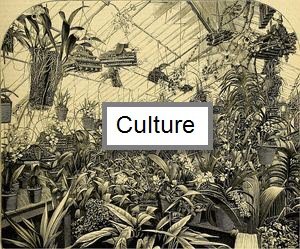Potting Media for Orchids are as Diverse as the Growers
AS THE ROOTS THRIVE, SO THRIVES the plant. When repotting time rolls around, it is important to consider the moisture holding capacity and drainage requirements of the particular orchid you are repotting and adjust its growing medium (plural: media) accordingly.
Orchids do not grow in soil. Most orchids are grown in potting mixes that may contain several components. By varying the percentages of each ingredient, you may create a mix that is quite moisture retentive or one that tends to the drier side.
The basis of most orchid mixes is some organic component that has at least a modest level of retaining moisture. The reasoning behind this is to mimic the bark that covers the limbs of the treetop perches where many epiphytic orchids make their homes. And indeed, bark chips are one of the most widely used ingredients in media.
Fir bark is most commonly employed. Coconut husk chips are another popular alternative and tend to be more moisture retentive than bark. Both of these are available in chunks of small, medium or large size. The best size depends primarily on the stature of the orchid or the relative size of its roots, i.e., finer roots generally need a finer medium. If you are a beginner, start with medium-sized chunks and try the coarser or finer ones as you learn to sense which of your plants might do better with larger or smaller air spaces around their roots.
Other organic ingredients that are used for orchid media include osmunda fiber, long-fiber sphagnum moss, tree fern, coir and cork. Osmunda fiber is the rather porous root mass from a fern and was formerly a popular growing medium for orchids. Moistened chunks were gently packed about the plant’s roots. Long-fiber sphagnum moss holds moisture for a long time, once wet, so it is popular for those orchids that need to retain plenty of moisture in the root zone. Coir (fibers of coconut husk) is sometimes used as a medium for species that need good drainage. Sphagnum and coir are more often used alone than in mixes.
Tree fern and cork are organic materials of a rather indestructible nature. Neither holds moisture well. Tree-fern fibers are the roots of tree fern plants and may be purchased as broken sticklike pieces that are useful in mixes to help add porosity. Cork is not used much in mixes, but chunks of it may be employed as a medium for certain thick rooted orchids.
While we all know that the primary function of roots is to absorb moisture for the plant, the roots of epiphytic orchids have adapted to gather moisture quickly, then become dry. Because a constantly damp growing medium is a certain death sentence for most orchids, inorganic components are usually added to orchid mixes to help ensure good drainage and air space around the roots.
Horticultural charcoal, lava rock and perlite are popular choices. Aliflor, an expanded clay product, is commonly used in some regions. These ingredients are available in varying sizes or grades so that you may select one that is in harmony with the sizes of your other ingredients.
If you are concocting your first orchid mix, and do not know what proportions or ingredients to use, try four or five parts bark or coconut husk chips to one part coarse perlite and one part horticultural charcoal. Feel free to vary the percentages as you choose. If you do not want to bother with such decisions, premixed orchid medium is usually available from most purveyors of orchid supplies.
